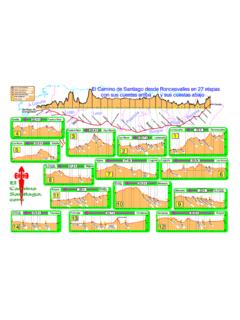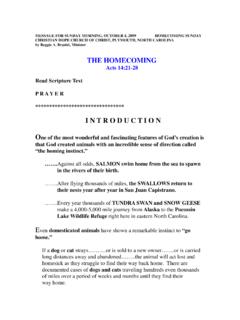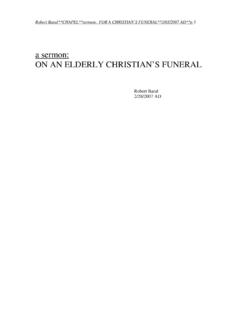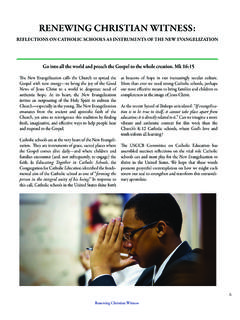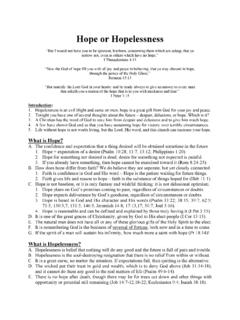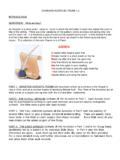Transcription of Christian Symbol and Ritual - El Camino Santiago
1 Christian Symbol and RitualThis page intentionally left blank Christian Symboland RitualAn Introductionbernard cookegary macy120051 Oxford University Press, Inc., publishes works that furtherOxford University s objective of excellencein research, scholarship, and New YorkAuckland Cape Town Dar es Salaam Hong Kong KarachiKuala Lumpur Madrid Melbourne Mexico City NairobiNew Delhi Shanghai Taipei TorontoWith offices inArgentina Austria Brazil Chile Czech Republic France GreeceGuatemala Hungary Italy Japan Poland Portugal SingaporeSouth Korea Switzerland Thailand Turkey Ukraine VietnamCopyright 2005 by Oxford University Press, by Oxford University Press, Madison Avenue, New York, New York is a registered trademark of Oxford University PressAll rights reserved. No part of this publication may be reproduced,stored in a retrieval system, or transmitted, in any form or by any means,electronic, mechanical, photocopying, recording, or otherwise,without the prior permission of Oxford University of Congress Cataloging-in-Publication DataCooke, Bernard Symbol and Ritual : an introduction / Bernard Cooke and Gary bibliographical references and 978-0-19-515411-5; 978-0-19-515412-2 (pbk.)
2 ISBN 0-19-515411-8; 0-19-515412-6 (pbk.)1. Liturgics. 2. Ritual . 3. Christian art and symbolism. 4. Theology, Macy, Gary. II. 2005264 dc222004029400987654321 Printed in the United States of Americaon acid-free paperTo Pauline Turner and Saralynn FerraraThis page intentionally left blank PrefaceThis is a book born directly from the classroom. We were bothteaching courses on the sacraments at the University of San Diego afew years back (in one case together), and both came to similar , the student body had changed dramatically over the lastfew decades. More and more students were coming from familiesthat had little or no regular religious practice. While the studentsmight consider themselves to be generically Christian or even specif-ically Lutheran Christians, Roman Catholic Christians, and so on,they had little or no understanding of their own traditions. Onesuch student, when she was assigned to read the Gospels, wasshocked to find out Jesus died.
3 A teacher simply could not takeany Christian background for granted. Many students were un-churched in any sense. They and their families practiced and pro-fessed no religion at all. The books we used to teach our courses,while excellent in themselves, simply assumed too much on thepart of the students. They used words like sacrament or grace or salvation as if the student already knew what these wordsmeant. Quite likely at the time when the texts were written, thiswas a fair assumption. Times, however, had changed, and so hadthe , most of the books on Christian rituals were books writ-ten from a Roman Catholic perspective deliberately for Roman Cath-viiiprefaceolics. There were few, if any, books written to introduce Christian rituals ingeneral, at least not books for undergraduate decided to do our best, therefore, to write a book that had two aims:first, to write an introduction to Christian Ritual that assumed the reader hadlittle or no background in Christianity; second, to write a book that attemptedto introduce the reader to Christian Ritual in general.
4 During the process ofwriting, different sections were used in class and tested and refined, as it were,under fire. Insofar as this small sample of students is useful, the methodseemed to a writer attempts to take nothing for granted, and when a text istempered by the questions of the classroom, the text tends to be written witha kind of anticipation. Most chapters include not only a description of a par-ticular Christian Ritual but also a theology to explain that Ritual , as well as thehistorical background to explicate the debates that still roil Christians concern-ing those rituals . We are attempting to answer the readers inevitable but questions: But then why do some Christians baptize children, while othersdon t? But why then is Sunday service different at my church? But why dosome Christians have priests and some ministers? This means the chaptersmay well seem to drift away from a discussion of Ritual per se.
5 We can alsobeg for your patience. We may be answering someone else s but questionrather than yours at the ultimate and practical purpose also motivated composition of thebook. In recent decades there has been a noticeable movement toward people sincreased activity in worship services. Pentecostal services have proved attrac-tive to thousands. In Roman Catholicism, the Second Vatican Council made ahistoric and revolutionary shift in its explanation of desirable Eucharistic cel-ebration, a shift from people attending Mass that is celebrated by an ordainedliturgical specialist to people s active participation in the celebration: a shiftfrom spectacle to Ritual . However and the council s document on the liturgystates this emphatically people can share consciously, intelligently, and effec-tively in Ritual only if they know what Ritual is and what their function in theEucharistic Ritual is.
6 We hope this book can help create such an understandingof clearly written by Roman Catholics, and while using Roman Ca-tholicism as the main examples, we hope that this will be a book that wouldbe accessible to all Christians. With over 130 years of Catholic life and expe-rience between us, our biases cannot help but show. We trust that these inev-itable predispositions will not alienate or book such as this owes so much to so many that it would hard to mentionall the influences that have shaped our thought over many years. We shouldprefaceixat least like to mention, however, Orlando Esp n, Michael Lawler, Susan Ross,Kenan Osborne, Geoffrey Wainwright, Catherine Bell, Bruce Morrill, JosephPowers, Raul Go mez, Dennis Krause, and Phyllis Zagano. Finally, we thankCynthia Read from Oxford University Press who encouraged us throughoutthe process and waited patiently for the final page intentionally left blank ContentsIntroduction:Symbolism, Root of Ritual , 31.
7 Characteristics and Functions of rituals , 192. rituals in the Christian Context, 353. rituals of Friendship, 554. rituals of Christian Initiation, 695. rituals of Prayer, Worship, and the Eucharist, 876. rituals of Reconciliation, 1097. rituals of Service and Ministry, 1198. rituals for Healing, Suffering, Death, 147 Conclusion: Christian Life as Ritual , 161 Suggestions for Further Reading, 171 Index, 175 This page intentionally left blank Christian Symbol and RitualThis page intentionally left blank IntroductionSymbolism, Root of RitualWhen you first opened this book, how did you do it? Just open it upto this page and start reading? Did you carefully open it in the mid-dle first so as not to break the binding? Did you check the notes andbibliography first to get a better idea of what sources the authorsused? Did you lick your finger in anticipation of page turning? Didyou quickly flip through the chapter headings to get an overall ideaof the book?
8 Maybe you did all or some of the above actions without reallythinking about them. It s just a habit after years of reading. You mayeven have a favorite place and time for reading; the evenings, per-haps, are reserved for novels while you snuggle deep into a favoritechair. Or maybe you have to read this book for a course; then youmight be chained to the desk, sitting straight up with pen poised fornotes and dread in your heart, faced with another dreary are that you have some Ritual habits with which youapproach a new book. Whether you are aware of it or not, even littleactions like picking up a new book usually involve rituals . We hopethat this book will make you more aware of how much of life ismade up of rituals , and how much those rituals do not just enrichyour life but even shape your of SymbolsFor now, however, it might be valuable just to take a moment and think of themany areas where rituals and symbols help structure one s day and ease onethrough everyday life.
9 Many people, especially in Western cultures, think ofthemselves as eminently practical. The actions that make up the bulk of theirlives are pragmatic, practical, functional. They are not wrong to think so, butcertainly they make a mistake if they think that Ritual actions are not pragmatic,practical, and functional. Take these letters as they march across the page:P A G E. Every single one is a Symbol . Every word is a Symbol ; every sentencestructures those symbols and is, in this sense, a Ritual . Language itself, so basicto human communication and knowledge, is both Symbol and Ritual . Clearly,language is both symbolic and ritualistic, but at the same time it is eminentlypractical and aid human interaction in other less obvious, but equally important,ways. Quite likely, as you move through your day, you encounter many peoplethat you know and you address them with Hi, how are you?
10 Or How s itgoing? or What s up? or some equivalent. The person so addressed is likelyto respond something like, Great! And how are you? or perhaps, Hangingin there or even So, so. Now, you probably don t really want to sit down andhear all about that person s present life, although this is actually what you areasking. Nor is it likely that the person really wants to tell you how their life isproceeding, although the responses Hanging in there and So, so leave openthe possibility for further inquiry. What is really taking place here is a are letting the person know that you recognize them and that, most likely,you don t have time to talk right now. They are saying that they appreciate therecognition, recognize you back, but, again most likely, don t have time to talk,although again, some responses leave open that fact, it would be annoying if the person responded, Well, you know,in general, things are good, but lately my lower back has been bothering mea bit and my car has been sounding funny, and then began to describe indetail the problems of their lives.
